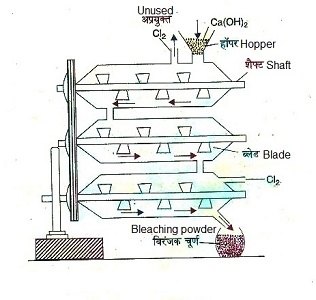प्रश्न 1. pH की परिभाषा दीजिए या pH मूल्य क्या है? pH तथा हाइड्रोजन आयन सान्द्रण में सम्बन्ध बताइए। इसकी सहायता से विलयन की प्रकृति कैसे ज्ञात करते हैं?
Define pH or what is pH value? Explain the relationship between pH and hydrogen ion concentration. How to determine the nature of solution with its help?
उत्तर – pH की परिभाषा – किसी विलयन का pH मान विलयन में उपस्थित हाइड्रोजन आयन सान्द्रण के ऋणात्मक लघुगणक के बराबर होता है जबकि लघुगणक का आधार 10 हो, अत: pH = -log10 [H+]
उपर्युक्त समीकरण हाइड्रोजन आयन सान्द्रण और pH में सम्बन्ध प्रदर्शित करता है।
विलयन की प्रकृति ज्ञात करना –
(i) यदि किसी विलयन का pH मान 7 है तो वह विलयन उदासीन होगा।
(ii) यदि किसी विलयन का pH मान 7 से कम अर्थात pH < 7 है तो विलयन अम्लीय होगा।
(iii) यदि किसी विलयन का pH मान 7 से अधिक है अर्थात pH > 7 तो विलयन क्षारीय होगा ।
Definition of pH – The pH value of a solution is equal to the negative logarithm of the hydrogen ion concentration present in the solution while the base of the logarithm is 10, hence pH = -log10 [H+]
The above equation shows the relationship between hydrogen ion concentration and pH.
Determining the nature of the solution –
(i) If the pH value of a solution is 7 then that solution will be neutral.
(ii) If the pH value of a solution is less than 7 i.e. pH < 7 then the solution will be acidic.
(iii) If the pH value of a solution is more than 7 i.e. pH > 7 then the solution will be alkaline.
प्रश्न 2. दैनिक जीवन में pH का महत्त्व समझाइए ।Explain the importance of pH in daily life.
उत्तर -दैनिक जीवन में pH का महत्त्व – दैनिक जीवन में pH का महत्त्व निम्नवत् है-
(i) हमारे पाचन तन्त्र में – लगभग 1.4 pH मान का तनु हाइड्रोक्लोरिक अम्ल (HCI) हमारे भोजन को पचाने में सहायता करता है।
(ii) दन्तक्षय रोकने में – जब हमारे मुख का pH मान 5.5 से कम होने लगता है तो दन्तक्षय होने लगता है। इसे रोकने के लिए को भलीभाँति साफ करना होता है तथा मंजन जिसका pH मान लगभग 8.0 हो, का प्रयोग करके दन्तक्षय रोका जा सकता है।
(iii) पौधों के वृद्धि में-अधिकांश पौधे सर्वोत्तम रूप से विकसित होते हैं जब मृदा का pH मान लगभग 7 के निकट होता जब मृदा अम्लीय हो जाती है तो CaO, CaCO3, Ca(OH)2 द्वारा मृदा का pH मान बढ़ाया जा सकता है।
Importance of pH in daily life – The importance of pH in daily life is as follows-
(i) In our digestive system – Dilute hydrochloric acid (HCI) of pH value about 1.4 helps in digesting our food.
(ii) To prevent tooth decay – When the pH value of our mouth starts falling below 5.5, then tooth decay starts occurring. To prevent this, the teeth have to be cleaned thoroughly and tooth decay can be prevented by using toothpaste whose pH value is around 8.0.
(iii) In plant growth – Most of the plants grow best when the pH value of the soil is near 7. When the soil becomes acidic then the pH value of the soil can be increased by CaO, CaCO3, Ca(OH)2. Is.
प्रश्न 3. विरंजक चूर्ण बनाने की हेसेनक्लेवर विधि का सचित्र वर्णन कीजिए। इसके दो मुख्य रासायनिक गुण लिखिए। Describe graphically the Hasenclever method of making bleaching powder. Write its two main chemical properties.
उत्तर – हेसेनक्लेवर विधि – इस विधि में लोहे के 6 या 8 पाइप क्षैतिजत: एक-दूसरे से जुड़े होते हैं। इन पाइपों में घूर्णी पंखे लगे होते हैं। ऊपर के प्रवेश मार्ग द्वारा शुष्क बुझा चूना डालते रहते हैं और नीचे से Cl2 गैस भेजी जाती है। इस प्रकार चूना क्लोरीन गैस से भली-भाँति मिश्रित होकर ब्लीचिंग पाउडर बनाता है।ब्लीचिंग पाउडर (विरंजक चूर्ण) को नीचे के रास्ते से निकालते रहते हैं।
Hasenclever Method – In this method, 6 or 8 iron pipes are connected to each other horizontally. Rotational fans are installed in these pipes. Dry slaked lime is kept pouring through the upper entrance and Cl2 gas is sent from the bottom. In this way, lime mixes well with chlorine gas and forms bleaching powder. The bleaching powder is kept coming out through the bottom path.
Ca(OH)2 + Cl2 → Ca(OCl)Cl + H2O
रासायनिक गुण- (i) जल से क्रिया – क्लोरीन गैस निकलती है।
Chemical properties – (i) Reaction with water – Chlorine gas is released.
CaOCl2 + H2O → Ca(OH)2 + Cl2 ↑
(ii) ऑक्सीकारक गुण (लेड ऑक्साइड से क्रिया) – लेड डाइऑक्साइड में ऑक्सीकृत कर देता है।
(ii) Oxidizing properties (reaction with lead oxide) – Oxidizes into lead dioxide.
2CaOCl2 + 2PbO → 2CaCl2 + 2PbO2





